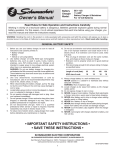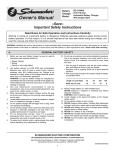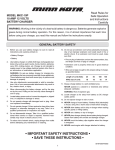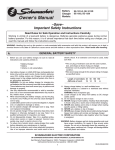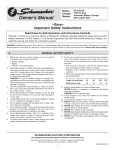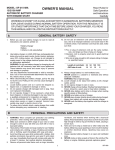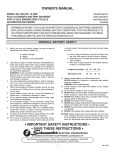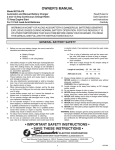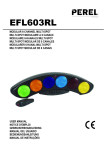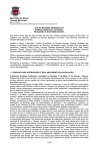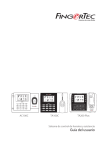Download Schumacher Electric SS-120A-PE Owner`s manual
Transcript
Battery Charger Model: Owner's Manual SS-51A-PE, 10 Amp Fully Automatic Battery Charger For 12 Volt Marine Deep Cycle & Automotive Batteries –Save– Important Safety Instructions Read Rules for Safe Operation and Instructions Carefully Working in vicinity of a lead-acid battery is dangerous. Batteries generate explosive gases during normal battery operation. For this reason, it is of utmost importance that each time before using your charger, you read this manual and follow the instructions exactly. WARNING: Handling the cord on this product or cords associated with accessories sold with this product, will expose you to lead, a chemical known to the State of California to cause cancer and birth defects or other reproductive harm. Wash hands after handling. GENERAL BATTERY SAFETY 1. Before you use your battery charger, be sure to read all instructions and cautions printed on: • Battery Charger • Battery • Vehicle or unit using battery 2. Use battery charger on LEAD ACID type rechargeable batteries only, such as used in autos, trucks, tractors, airplanes, vans, RVs, trolling motors, etc. Charger is not intended to supply power to low-voltage electrical system other than in an automotive application. WARNING: Do not use battery charger for charging drycell batteries that are commonly used with home appliances. These batteries may burst and cause injury to persons and damage to property. 3. Use only attachments recommended or sold by manufacturer. Use of non-recommended attachments may result in fire, electric shock, or injury. 4. When disconnecting the battery charger, pull by the plug not by the cord. Pulling on the cord may cause damage to cord or plug. 5. Locate battery power cord so it cannot be stepped on, tripped over, or subjected to damage or stress. 6. Do not operate charger with damaged cord or plug. Have cord replaced immediately. 7. Do not operate charger if it has received a sharp blow, been dropped, or otherwise damaged in any way. Take it to a qualified professional for inspection and repair. 8. Do not disassemble charger. Take it to a qualified professional when service or repair is required. Incorrect reassembly may result in electric shock or fire. 9. To reduce risk of electric shock, unplug charger from outlet before attempting any maintenance or cleaning. 10. Do not use an extension cord unless absolutely necessary. Use of an improper extension cord could result in fire or electric shock. If an extension cord must be used, make sure that: • Pins on plug of extension cord are the same number, size, and shape as those of plug on charger. • Extension cord is properly wired and in good electrical condition. • Wire size is large enough for AC ampere rating of charger, as specified below: Length of cord (feet): 25 50 100 150 AWG size of cord: 18 18 16 14 11. Always charge battery in a well ventilated area. NEVER operate in a closed-in or restricted area without adequate ventilation. WARNING: Risk of explosive gas. 12. Locate charger as far away from battery as DC charger cables permit. 13. Do not expose charger to rain or snow. 14. NEVER charge a frozen battery. If battery fluid (electrolyte) is frozen, bring into a warm area to thaw before charging. 15. NEVER allow battery acid to drip on charger when reading specific gravity or filling battery. 16. NEVER set a battery on top of charger. 17. NEVER place charger directly above battery being charged. Gases from battery will corrode and damage charger. 18. NEVER touch the battery clips together when the charger is energized. 19. NEVER crank engine with charger attached to battery. WARNING: Battery chargers get hot during operation and must have proper ventilation. Air needs to flow around entire charger. Do not set on flammable items like carpeting, upholstery, paper, cardboard, etc. Will damage leather and melt plastic and rubber. SCHUMACHER ELECTRIC CORPORATION 801 BUSINESS CENTER DRIVE • MOUNT PROSPECT, ILLINOIS 60056-2179 Send Warranty Product Repairs to: 1025 E. Thompson, Hoopeston, IL 60942-0280 Call Customer Service if you have questions: 1-800-621-5485 00-00-000558/0103 1 PERSONAL PRECAUTIONS AND SAFETY 5. Remove all personal metal items such as rings, bracelets, necklaces, and watches when working with a lead-acid battery. A lead-acid battery can produce a short-circuit current high enough to weld a ring (or the like) to metal, causing a severe burn. 1. WARNING: Wear complete eye protection and clothing protection when working with lead-acid batteries. 2. Make sure someone is within range of your voice or close enough to come to your aid when you work with or near a lead-acid battery. 6. Take care not to drop a metal tool or other metal onto the battery. Metal may cause sparking or short circuit the battery or another electrical device. Sparking may cause an explosion. 3. Have plenty of fresh water and soap nearby for use if battery acid contacts skin, clothing, or eyes. If battery acid contacts skin or clothing, wash immediately with soap and water. 7. Always operate battery charger in an open, wellventilated area. 4. Avoid touching your eyes while working with a battery. Acid particles (corrosion) may get into your eyes! If acid enters your eye, immediately flood eye with running cold water for at least 10 minutes. Get medical attention immediately. 8. NEVER smoke or allow a spark or flame in the vicinity of the battery or engine. Batteries generate explosive gases! PREPARING TO CHARGE BATTERY SIZE/RATING 1. Make sure you have a 12 volt lead-acid battery. Check car owner manual to make sure. 2. Clean battery terminals. Take care to keep corrosion from coming in contact with your eyes. 3. If required, add distilled water in each cell until battery acid reaches levels specified by battery manufacturer. This helps purge excessive gas from cells. Do not overfill. For a battery without cell caps, carefully follow manufacturer's recharging instructions. 4. Study all battery manufacturer's specific precautions, such as removing or not removing cell caps while charging, and recommended rates of charge. BATTERY SIZE RATING CARS / LIGHT TRUCKS CCA 200-315 315-550 550-850 RC 40-60 60-85 85-150 3-5 5-9 9-13 MARINE OR DEEP CYCLE MCA 220-350 350-600 600-935 AH 24-40 40-70 70-104 3-5 5-9 9-13 CCA: COLD CRANKING AMPS MCA: MARINE CRANKING AMPS 5. Be sure area around battery is well ventilated while battery is being charged. Gas can be forcefully blown away by using a piece of cardboard or other non-metallic material as a fan. RECHARGE TIME-HOURS* RC: RESERVE CAPACITY AH: AMPERE HOUR *Based on battery at 50% charge. Not sure of your BATTERY TYPE?: If you are unsure you have a Deep Cycle battery, charge your battery using any of the following settings: Low Maintenance, Conventional or Regular. All automotive (car & truck) batteries are "Regular" batteries not "Deep Cycle". Deep Cycle batteries are used on equipment without alternators or generators like golf cars, personnel carriers, high lifts, floor sweepers etc.. 6. If necessary to remove battery from vehicle to charge, always remove grounded terminal from battery first. Make sure all accessories in the vehicle are off, so as not to cause an arc. Not recommended for the Delco Voyager® batteries or similar. 7. A marine (boat) battery must be removed and charged on shore. To charge it on board requires equipment specially designed for marine use. 2 BATTERY CHARGER CONTROLS D C AMPS 2 4 CHARGING 6 8 10 12 CHARGE COMPLETE IO AMP FULLY AUTOMATIC BATTERY CHARGER ▲ MANUAL ▲ CHARGED AUTOMATIC FIGURE 3 CHARGER CONTROLS MANUAL-AUTOMATIC SWITCH Charging may be either Manual or Automatic. NOTE: Some batteries, especially those with a built in state of charge indicator and have been deeply discharged, may require the use of the MANUAL position in order to obtain full charge. The AUTOMATIC position may be used to maintain the full charge state. MANUAL When the Manual position is selected the charger will continue to charge and will not shut off. You must keep a visual check on the ammeter or the green LED to determine when the battery is charged. When the ammeter reads around 5 Amps and the green LED is on the battery is charged. WARNING: In the Manual position, the charger will continue to charge even after the battery is fully charged. WARNING: Overcharging will damage the battery. METER/LED INDICATOR The meter gives a reading of the AMP draw on the charger. When a fully discharged battery is connected to the charger, the meter will read the maximum output rating of the charger. The charge current will gradually taper down as the battery approaches full charge. As the charge current tapers, the meter needle will also move down. AUTOMATIC CHARGING When the battery reaches the full charge state, charge current is turned off and the charger switches to the maintainer mode of operation. This action occurs when the ammeter tapers down to approximately 5 Amps. In this state the battery voltage is constantly being monitored. When the battery voltage drops to a predetermined value charge will turn on for a few seconds replacing the small amount of energy that was lost while the charge current was at 0 Amps. When full charged, the meter needle will suddenly drop to 0 and a green LED will turn on. The 0 is not printed on the meter scale, the LED is located in its place. As a visual aid, the meter scale has been divided into 2 zones, CHARGED and CHARGING. NOTE: As the battery approaches the full charge state the meter needle and LED will fluctuate back and forth between CHARGING and CHARGED. For the average size automotive battery, allow 5 to 10 minutes for the battery to stabilize. MANUAL VS AUTOMATIC CHARGING For your safety, in the AUTOMATIC position this charger will only turn on when properly connected to a 12 volt battery with a voltage over .7 volts. In the MANUAL position the charger will turn on for any condition. If a battery is so depleted of charge that it's voltage is less than .7 volts, switch to MANUAL until the ammeter begins to move up scale, than switch back to the desired AUTOMATIC position. NOTE: A buzz or hum is normal when the output cables have been disconnected and the AC power cord is still connected to an electrical source (i.e. wall outlet). These types of noises will also occur when the green light comes on indicating the battery is "Completely Charged". At this point, the charger has stopped charging the battery, but still hums or buzzes until the electrical power is shut off. 3 READING METER D C AMPS CHARGED 2 4 D C AMPS CHARGING 6 8 10 12 CHARGE COMPLETE FULLY DISCHARGED BATTERY Initial charge current to the battery is typically 10 Amps. CHARGED 2 4 D C AMPS CHARGING 6 8 10 12 CHARGED 2 4 CHARGING 6 8 10 12 CHARGE COMPLETE CHARGE COMPLETE APPROACHING FULL CHARGE Charge current to the battery is typically 6 Amps. FULLY CHARGED BATTERY Charge current to the battery is 0 Amps and the green LED is on. CIRCUIT BREAKER This battery charger is equipped with a self-resetting circuit breaker. This device protects the charger from temporary overloads. In the event of an overload, the circuit breaker will trip open and after a short cooling off period will reset automatically. This process is known as cycling and can be recognized by an audible clicking sound. NOTE: Clicking sound is normal. Wait until charger automatically resets itself. CAUTION: Persistent clicking (more than 30 minutes) may indicate reverse connection or shorted battery cells. (See TROUBLESHOOTING) BATTERY TYPES Three basic types of lead-acid batteries can be given a charge with this charger: (1) Conventional and Low Maintenance, (2) Maintenance Free, (3) Deep Cycle / Marine. water additions, the battery is probably a Low Maintenance/ Conventional type. Conventional and Low Maintenance Batteries. These are the antimony/lead batteries. Conventional/Low Maintenance batteries require periodic addition of water to the acid solution (electrolyte). Additional water may be added by removing the filler caps located on the top of the battery. Maintenance Free Batteries. These are calcium/lead batteries and normally do not require water additions. Therefore, filler caps have been removed from the battery surface. These batteries will have a smooth or sealed appearance. IMPORTANT: When antimony is known to be one of the materials used in the battery's construction, that battery is a Low Maintenance/Conventional type. Deep Cycle Batteries. These heavy duty batteries are used in boats, construction equipment, sump pumps, etc. They are normally marked DEEP CYCLE on the outside of the case. CAUTION: Some Low Maintenance batteries have a relatively smooth top without any apparent battery filler caps. If, however, the battery manufacturer/distributor recommends periodic checking of electrolyte level and provides access to the battery for OPERATING INSTRUCTIONS: CHARGING BATTERY OUT OF THE VEHICLE When charging battery out of the vehicle, take care to determine the battery type. To reduce risk of a spark near battery, follow these steps when battery is outside vehicle. WARNING: A spark near battery may cause battery explosion. WARNING: When removing battery from vehicle or boat, disconnect grounded post first. When disconnecting, make sure all accessories are off, so as not to cause an arc. (NOTE: A marine (boat) battery must be removed and charged on shore. (To charge on board requires special equipment designed for marine use.) WARNING: When reinstalling battery, attach the ground post first. 4 1. Check polarity of battery posts. Battery case will be marked by each post: POSITIVE (POS, P, +) and NEGATIVE (NEG, N, -). NOTE: The positive battery post usually has a larger diameter than the negative post. 2. Attach a 24-inch long (or longer) 6-gauge (AWG) insulated battery cable to NEGATIVE (NEG, N, -) battery post. (Purchase cable separately.) 3. Connect POSITIVE (RED) charger clamp to POSITIVE (POS, P, +) battery post. Rock clamp back and forth to make good connection. 4. BATTERY CHARGER BATTERY 6. Select automatic or manual charging, see Charger Controls. 7. When battery is fully charged, unplug charger from AC power source. POWER CORD TO GROUNDED POWER OUTLET FIGURE 1: CONNECT NEGATIVE BATTERY CLAMP TO 24-INCH CABLE END FIGURE 1 shows the connection. Plug charger AC cord into 120 volt outlet. + 24", 6 GUAGE CABLE Position yourself and free end of 24-inch cable as far away from battery as possible. Then connect NEGATIVE (BLACK) charger clamp to free end of cable. WARNING: Do not face battery when making final connection. Rock clamp back and forth to make a good connection. 5. NEGATIVE POSITIVE 8. When battery is fully charged and charger is unplugged, (1) remove clamp from end of Negative end of cable, and (2) remove clamp from Positive battery post, in that order. 9. Clean and store battery charger. OPERATING INSTRUCTIONS: CHARGING BATTERY IN VEHICLE When charging battery in vehicle, take care to determine the battery type and which pole is grounded. To reduce risk of a spark near battery, follow these steps when battery is inside vehicle. WARNING: A spark near the battery may cause battery explosion. 1. Position AC power cord and DC charging cords to reduce risk of damage by hood, door, or moving engine parts. 2. Stay clear of fan blades, belts, pulleys, and other parts that can cause injury. 3. Check polarity of battery posts. Battery case will be marked by each post: POSITIVE (POS, P, +) and NEGATIVE (NEG, N, -). NOTE: The positive battery post usually has a larger diameter than the negative post. 4. Determine which post of battery is grounded (connected) to chassis. NOTE: The negative post is normally grounded. GROUND (NEG) NEGATIVE GROUNDED POST 5A. For negative-grounded vehicle, connect POSITIVE (RED) clamp from battery charger to POSITIVE (POS, P, +) ungrounded post of battery. Connect NEGATIVE (BLACK) clamp to vehicle chassis or engine block away from battery. Connect to a heavy-gauge metal part of the frame or engine block. FIGURE 2: CONNECTION TO NEGATIVE GROUNDED BATTERY WARNING: Do not connect clip to carburetor, fuel lines, or sheetmetal body parts. NOTE: Attach clamps to battery post and twist or rock back and forth several times to make a good connection. This tends to keep clamps from slipping off terminals and helps to reduce risk of sparking. FIGURE 2 shows connections for a negative-grounded battery. POSITIVE GROUNDED POST 5B. For positive-grounded vehicle, connect NEGATIVE (BLACK) clamp from battery charger to NEGATIVE (NEG, N, -) ungrounded post of battery. Connect POSITIVE (RED) clamp to vehicle chassis or engine block away from battery. Connect to a heavy-gauge metal part of the frame or engine block. 6. Plug charger AC cord into a grounded 120 volt outlet. 7. Select either automatic or manual, see Charger Controls. 8. When battery is fully charged, unplug charger from AC power source. 9. Remove charger clamps from (1) chassis and (2) battery post, in that order. 10. Clean and store battery charger. NOTE: Charger will hum when clamps are removed from battery and power cord is still plugged into electrical outlet. 5 TROUBLESHOOTING The battery charger is designed to work automatically. However, If a problem does occur, check the following: PROBLEM POSSIBLE SOLUTION No meter reading. Charger is not plugged in Plug in Connections are reversed. With charger unplugged, reverse clamps and reconnect (rock back and forth to bite in). Poor electrical connection. Clean clamps and battery poles and reconnect (rock back and forth to bite in). AC outlet is dead. Plug in a lamp or other appliance to check for voltage. Battery is defective (will not accept charge). Have battery checked. Battery recently used in vehicle and is fully charged. Battery does not need changing. Charger will not turn on when properly connected to power. (If battery is in vehicle, turning on headlights will lower battery voltage in a few seconds and charger should then turn on.) Battery has less than .7 volts, set to Manual and retry. Charger will not turn OFF. Battery has a problem and will not take a Have battery checked. full charge. (If in MANUAL, switch to AUTOMATIC). Meter needle pulses (fluctuates) every few seconds AFTER THREE HOURS without slowing down. Two or more batteries connected in parallel. Requires more time to charge: continue charging. Battery of 200 ampere hours or larger. Requires more time to charge: continue charging. Battery is connected to application that draws a small current (such as a vehicle's dome light). Requires more time to charge: continue charging. Battery is partially charged. Continue charging. Battery is defective (battery plates are crusted) and will not accept a full charge. Have checked and replace battery. AC power supply is low. Plug charger into another grounded AC outlet. Severely discharged battery (but otherwise good battery). Allow charging to continue until battery has recovered sufficiently to take a charge (Circuit breaker will continue to cycle and needle will swing side to side until battery has recovered). In MANUAL with battery connections reversed. Unplug charger and change to correct connections. Battery is defective (will not accept charge) Have battery checked. Charger is cycling after circuit breaking overload. Wait until charger automatically resets itself Charging current is less than full output rating of charger. Meter needle moves to extreme right, remains a short time, then returns to zero, accompanied by a clicking sound. 6 (DO NOT RETURN FOR SERVICE). MAINTENANCE/CLEANING INSTRUCTIONS Very little maintenance is required for the battery charger. Follow common sense in wiping the charger clean and store in a clean, dry area. 1. 2. 3. After use, wipe all battery corrosion and other dirt or oil from clamp, cord, and the charger case. Use a dry cloth. Coil charger cords to prevent damage. 4. Have any cracked or frayed cords replaced by a qualified professional. Store battery charger in a clean, dry area. LIMITED WARRANTY THIS IS THE ONLY EXPRESS LIMITED WARRANTY AND THE MANUFACTURER NEITHER ASSUMES NOR AUTHORIZES ANYONE TO ASSUME OR MAKE ANY OTHER OBLIGATION TOWARDS THE PRODUCT OTHER THAN THIS EXPRESS LIMITED WARRANTY. THE MANUFACTURER MAKES NO WARRANTY OF MERCHANTABILITY OR FITNESS FOR PURPOSE OF THIS PRODUCT AND EXPRESSLY EXCLUDES SUCH FROM THIS LIMITED WARRANTY. SCHUMACHER ELECTRIC CORPORATION, 801 BUSINESS CENTER DRIVE, MOUNT PROSPECT, ILLINOIS 600562179 MAKES THIS LIMITED WARRANTY TO THE ORIGINAL PURCHASER AT RETAIL OF THIS PRODUCT. THIS LIMITED WARRANTY IS NOT TRANSFERABLE. Schumacher Electric Corporation warrants this battery charger for two years from date of purchase at retail against defective material or workmanship. If such should occur, the unit will be repaired or replaced at the option of the manufacturer. It is the obligation of the purchaser to forward the unit together with proof of purchase, transportation and/or mailing charges prepaid to the manufacturer or its authorized representative. SOME STATES DO NOT ALLOW THE EXCLUSION OR LIMITATION OF INCIDENTAL OR CONSEQUENTIAL DAMAGES OR LENGTH OF IMPLIED WARRANTY SO THE ABOVE LIMITATIONS OR EXCLUSIONS MAY NOT APPLY TO YOU. THIS WARRANTY GIVES YOU SPECIFIC LEGAL RIGHTS AND YOU MAY ALSO HAVE OTHER RIGHTS WHICH VARY FROM STATE TO STATE. This limited warranty is void if the product is misused, subjected to careless handling, or repaired by anyone other than the manufacturer or its authorized representative. The manufacturer makes no warranty other than this limited warranty and expressly excludes any implied warranty including any warranty for consequential damages. 7 • IMPORTANT SAFETY INSTRUCTIONS • • SAVE THESE INSTRUCTIONS • ELECTRIC CORPORATION 801 BUSINESS CENTER DRIVE • MOUNT PROSPECT, ILLINOIS 60056-2179 Send Warranty Product Repairs to: 1025 E. Thompson Avenue, Hoopeston, IL 60942-0280 Call Customer Service if you have questions: 1-800-621-5485 8 Cargador SS-51A-PE, 10 Amperios 12 Voltios de bateria Cargador de Acumuladores Modelo: Manual del Usuario –No destruya este manual– Instrucciones Importantes De Seguridad Lea con detenimiento estas instrucciones y reglas para utilizarlas con seguridad. El trabajar cerca de baterías de plomo-ácido es peligroso. Las baterías generan gases explosivos durante su operación normal. Por esta razón, es de gran importancia que cada vez que utilice su cargador, lea este manual y siga sus instrucciones exactamente. ADVERTENCIA - El manejo del cordón en este producto, o de los cordones asociados con los accesorios vendidos con este producto, le expone a usted al plomo, un producto químico conocido en el Estado de California de causar cáncer y defectos de nacimiento u otros daños reproductivos. Lávese las manos después de manejar estos cordones. SEGURIDAD GENERAL DE LA BATERIA 1. Antes de usar su cargador de batería, asegúrese de leer todas las instrucciones y los avisos de precauciones impresos en: • El cargador de batería • La batería • El vehículo o la unidad que usa la batería 2. Use el cargador de batería sólo en baterías recargables de tipo PLOMO-ACIDO, tales como aquellas usadas en trocas, carros, tractores, aviones, motores de troles, camionetas, RV, etc. El cargador no está diseñado para suministrar energía a un sistema eléctrico de bajo voltaje diferente a una aplicación automotriz. ADVERTENCIA: No use el cargador de batería para cargar baterías de célula seca que se usan comúnmente con artefactos domésticos. Estas baterías pueden reventar y causar lesiones a las personas y daños a la propiedad. 3. Use sólo los aditamentos recomendados o vendidos por el fabricante. El uso de aditamentos no recomendados puede resultar en un incendio, choque eléctrico o lesiones. 4. Al desconectar el cargador de batería, tire del enchufe y no del cordón. El tirar del cordón puede causar daño al cordón o al enchufe. 5. Coloque el cordón de potencia de la batería de manera que no pueda pisarse, tropezarse con el mismo, o que esté expuesto a daño o esfuerzo. 6. No opere el cargador con un cordón o enchufe dañado. Haga que el cordón sea reemplazado inmediatamente. 7. No opere el cargador si ha recibido un golpe fuerte, se ha caído o se ha dañado de alguna manera. Llévelo a un profesional calificado para inspeccionar y reparar. 8. No desarme el cargador. Llévelo a un profesional calificado cuando se requiera servicio o reparación. Un rearmado incorrecto puede resultar en un choque eléctrico o en un incendio. 9. Desenchufe el cargador del tomacorriente antes de tratar de mantener o limpiar, para reducir el riesgo de choque eléctrico. 10. No use un cordón de extensión a menos que sea absolutamente necesario. El uso de un cable de extensión incorrecto podría resultar en incendio o choque eléctrico. Si debe usarse un cable de extensión, asegúrese que: • Las clavijas del enchufe del cable de extensión sean iguales en cantidad, tamaño y forma a aquéllas del enchufe en el cargador. • El cable de extensión esté apropiadamente cableado y en buen estado eléctrico. • El tamaño del conductor sea suficientemente grande como para la clasificación de amperios de CA del cargador, según se especifica abajo: Longitud del cable (pies): Tamaño AWG del cable: 25 16 50 12 100 10 150 8 (Calibre Americano de Conductor) 11. Cambie siempre la batería en un área bien ventilada. A causa del riesgo de gases explosivos, NUNCA opere en un área cerrada o restringida sin ventilación adecuada. 12. Coloque el cargador tan alejado como sea posible de la batería, a la máxima distancia permitida por los cables del cargador de CC. 13. No exponga el cargador a la lluvia ni a la nieve. 14. NUNCA cargue una batería congelada. Llévela a un área cálida para descongelarla antes de cargar, si el fluido (electrolito) de la batería está congelado. 15. NUNCA permita que el ácido de la batería gotee sobre un cargador al leer la gravedad específica o al llenar la batería. 16. NUNCA coloque el cargador directamente sobre la batería a cargar. Los gases de la batería desgastarán y dañarán el cargador. 17. Al activar el cargador, NUNCA toque al mismo tiempo las pinzas de conexión. 18. NUNCA junte las pinzas de los cables (una con otra) cuando esté engergizado el cardador. 19. NUNCA arranque un motor cuando el cargador esté conectado al acumulador. SCHUMACHER ELECTRIC CORPORATION 801 BUSINESS CENTER DRIVE • MOUNT PROSPECT, ILLINOIS 60056-2179 Para reparación del producto baja garantía, envíelo a:1025 E. Thompson, Hoopeston, IL 60942-0280. Para más información comuníquese al Dep. de Servicios al Cliente: 1-800-621-5485 1 PRECAUCIONES Y SEGURIDAD PERSONALES 1. 2. 3. 4. ADVERTENCIA: Al trabajar con baterías de plomo-ácido, use protección completa de los ojos y protección de la ropa. Cuando usted trabaje con o esté cerca de una batería de plomo-ácido, asegúrese que alguien esté al alcance de su voz o suficientemente cerca como para ayudarlo. Tenga a mano agua y jabón para usar si el ácido de la batería entra en contacto con la piel, la ropa o los ojos. Lave inmediatamente con jabón y agua si el ácido de la batería entra en contacto la piel o la ropa. Al trabajar con una batería, evite tocar sus ojos. ¡Las partículas ácidas (corrosión) pueden entrar en sus ojos! Lave inmediatamente el ojo con agua corriente fría durante un mínimo de 10 minutos si el ácido penetra en el mismo. Busque atención médica inmediata. 5. 6. 7. 8. Al trabajar con una batería de plomo-ácido, quítese todos los artículos personales de metal tales como anillos, brazaletes, collares y relojes. Una batería de plomo-ácido puede producir una corriente de cortocircuito suficientemente intensa como para soldar un anillo (u objetos similares) al metal, causando una quemadura grave. Tenga cuidado en no dejar caer una herramienta de metal u otro metal sobre la batería. El metal puede causar chispas o colocar en cortocircuito la batería u otro artefacto eléctrico. Las chispas pueden causar una explosión. Opere siempre el cargador de batería en un área abierta y bien ventilada. NUNCA fume ni permita chispas o llamas en la vecindad de la batería o del motor. ¡Las baterías generan gases explosivos! PREPARANDO LA CARGA 1. 2. 3. 4. 5. 6. 7. Asegúrese que tenga una batería de 12 voltios o de 6 voltios de plomo-ácido y seleccione correspondientemente el interruptor del cargador de la batería. Limpie los terminales de la batería. Tenga cuidado para evitar que la corrosión entre en contacto con sus ojos. Si fuera requerido, agregue agua destilada a cada célula hasta que el ácido de la batería alcance los niveles especificados por el fabricante de la batería. Esto ayuda a purgar el gas excesivo de las células. No llene en exceso. Siga cuidadosamente las instrucciones de recarga del fabricante para una batería sin tapas individuales de las células. Estudie todas las precauciones específicas del fabricante de la batería, tales como sacar o no sacar las tapas de las células al cargar y velocidades recomendadas de carga. Asegúrese que el área alrededor de la batería esté bien ventilada mientras se carga la batería. El gas puede soplarse alejado usando una pieza de cartón u otro material no metálico como un abanico. Saque siempre el terminal conectado a tierra primero, si fuera necesario sacar la batería del vehículo para cargar. Asegúrese que todos los accesorios en el vehículo estén desconectados de manera que no puedan originar un arco eléctrico. Una batería marina (de barco) puede sacarse y cargarse en tierra. La carga a bordo requiere equipo especialmente diseñado para uso marino. TAMAÑO Y CAPACIDAD DE ACUMULADORES AUTOMOVILES Y CAMIONETAS MARINOS O DEEP CYCLE CCA RES. CAP CARGA HORAS 200-315 315-550 550-850 40-60 60-85 85-150 3-5 5-9 9-13 MCA AMP HR 220-350 350-600 600-935 24-40 40-70 70-104 CCA: ARRANQUE FRIO AMPERIOS MCA: ARRANQUE MARINO AMPERIOS 2 3-5 5-9 9-13 RES. CAP.: CAP. DE RESERVA AMP HR: HORAS AMPERIOS CONTROLES DEL CARGADOR DE ACUMULADORES D C AMPS 2 4 CHARGING 6 8 10 12 CHARGE COMPLETE IO AMP FULLY AUTOMATIC BATTERY CHARGER ▲ MANUAL ▲ CHARGED AUTOMATIC NOTA: Con algunos acumuladores, en especial los que tienen incorporados indicadores de carga y que han sido cargados completamente, puede ser necesario cargarlos MANUALMENTE para lograr una carga completa. La carga AUTOMATICA se puede usar para mantener el estado de carga completa. MANUAL-AUTOMATIC SWITCH INTERRUPTOR MANUAL-AUTOMATICO Se puede cargar manual o automáticamente. MANUAL Al estar en MANUAL, el cargador no se apaga. Se tiene que vigilar y revisar el amperímetro y/o el diodo emisor de luz verde para determinar cuándo está cargado el acumulador. Cuando el amperímetro tenga una lectura aproximada de 5A y el diodo emisor de luz verde esté iluminado, el acumulador estará cargado. ADVERTENCIA: En MANUAL, el cargador continúa cargando, aún después de que esté completamente cargado el acumulador. ADVERTENCIA: Una sobrecarga dañará el acumulador. AMPERIMETRO E INDICADOR LED El amperímetro indica una lectura en amperios de la llamada de corriente del cargador. Cuando se conecta un acumulador completamente descargado al amperímetro, éste tendrá una lectura de la capacidad máxima de salida del cargador. La corriente de carga disminuirá lentamente conforme se llega a la carga completa del acumulador. Al disminuir la corriente de carga, la aguja del amperímetro baja también. CARGA AUTOMATICA: Cuando el acumulador llega a su carga completa, se apaga la corriente y el cargador cambia a la función de mantenimiento. Esto ocurre cuando el amperímetro baja a aproximadamente 5A. En este modo, la tensión del acumulador baja a un valor de carga previamente determinado para reponer la carga pequeña que se pierde durante el tiempo que la tensión esté a cero amperios. Cuando el acumulador esté completamente cargado, la aguja del amperímetro pasa repentinamente a cero y se ilumina el diodo emisor de luz verde. El cero no está impreso en la escala y en su lugar se encuentra el diodo emisor de luz. Como ayuda visual, la escala del medidor está dividida en dos zonas: CARGADO Y CARGANDO. CARGA MANUAL COMPARADA A LA AUTOMATICA Para su seguridad, en carga AUTOMATICA este cargador se enciende cuando esté correctamente conectado a un acumulador de 12 voltios con un voltaje de más de 0,7V. En MANUAL, el cargador funcionará bajo cualquier condición. Si un acumulador tiene una carga tan débil que es menos de 0,7V, cambie a MANUAL hasta que el amperímetro indique una carga en la escala y luego cambie a carga AUTOMATICA. NOTA: Conforme llega el acumulador a la carga completa, la aguja del amperímetro y el diodo emisor de luz cambiarán de CARGANDO a CARGADO. Para acumuladores automotrices de tamaño normal, permita que se estabilicen de 5 a 10 minutos. 3 LECTURA DEL AMPERIMETRO D C AMPS CHARGED 2 4 D C AMPS CHARGING 6 8 10 12 CHARGE COMPLETE ACUMULADOR COMPLETAMENTE DESCARGADO. La corriente de carga inicial al acumulador es, típicamente, de 10A. CHARGED 2 4 D C AMPS CHARGING 6 8 10 12 CHARGE COMPLETE AL LLEGAR A LA CARGA COMPLETA. La corriente de carga al acumulador es, típicamente, de 5A. CHARGED 2 4 CHARGING 6 8 10 12 CHARGE COMPLETE ACUMULADOR COMPLETAMENTE CARGADO. La corriente de carga al acumulador es de 0 amperios y se ilumina el diodo emisor de luz verde. INTERRUPTOR DE CIRCUITO NOTA: El sonido seco es normal. Espere hasta que el cargador se reenganche por sí sólo automáticamente. PRECAUCIÓN: Si persiste el sonido seco (por más de 30 minutos) podría indicar que hay una conexión invertida o que una celda de la batería hizo cortocircuito. (Vea DETECCION DE DESPERFECTOS) Este cargador de batería esta equipado con un interruptor de circuito para auto-restablecimiento. Este dispositivo protege al cargador de cualquier sobrecarga temporal. En el caso que ocurra una sobrecarga, el interruptor de circuito se desenganchará y después de un corto período de enfriamiento, se reenganchará automáticamente. Este proceso es conocido como el «reenganche», y podrá saber que está ocurriendo cuando escuche un «click» o sonido seco. TIPOS DE BATERIA Se pueden cargar tres tipos de baterías de ácido de plomo con este cargador: (1) Convencionales y de Poco Mantenimiento. (2) Que No Requieren Mantenimiento. (3) De Ciclo Profundo. (/Marino) Baterías que no requieren mantenimiento. Estas son las baterías de plomo/calcio y normalmente no necesitan ser rellenadas de agua. Por lo tanto, los tapones de relleno de agua han sido eliminados de la superficie de la batería. Estas baterías tendrán una apariencia lisa o sellada. Baterías convencionales y de poco mantenimiento. Estas baterías son las baterías de plomo/antimonio. Las baterías convencionales/de poco mantenimiento necesitan que se agregue agua periódicamente a la solución ácida (electrólito). Para rellenar de agua se deben quitar los tapones que están localizados en la parte superior de la batería. Baterías de Ciclaje Profundo. Estas baterías de gran potencia, son usadas en barcos, equipo de construcción, bombas de cisterna, etc. Normalmente están marcadas DEEP CYCLE (Ciclaje Profundo) en la parte exterior de la caja de la batería. IMPORTANTE: Cuando se sabe que se usó antimonio como uno de los materiales para fabricar la batería, la batería es del tipo convencional/de poco mantenimiento. PRECAUCIÓN: Algunas baterías de poco mantenimiento tienen unasuperficie relativamente plana y es difícil identificar los tapones para el relleno. Sin embargo, si los fabricantes o distribuidores recomiendan que se efectúe una revisión periódica del nivel de electrólito y proporcionan acceso a la batería para agregarle agua, la batería es probablemente del tipo convencional/de poco mantenimiento. INSTUCCIONES DE OPERACION: CARGA DE LA BATERIA FUERA DEL VEHICULO Tenga cuidado en determinar el tipo de batería al cargarla fuera del vehículo. Para reducir el riesgo de una chispa cerca de la batería, siga estos pasos cuando la batería está fuera del vehículo. ADVERTENCIA: Al sacar la batería del vehículo o del barco, desconecte primero el polo conectado a tierra. Al desconectar, asegúrese que todos los accesorios estén desconectados de manera que no puedan causar un arco eléctrico. (NOTA: Una batería marina (de barco) debe sacarse y cargarse en tierra. (La carga a bordo requiere equipo especial diseñado para uso marino.) ADVERTENCIA: Fije el poste conectado a tierra primero al instalar nuevamente la batería. 4 1. 2. 3. 4. 5. 6. 7. Inspeccione la polaridad de los postes de la batería. La caja de la batería estará marcada por cada poste: POSITIVA (POS, P, +) y NEGATIVA (NEG, N, -). NOTA: El poste positivo de la batería generalmente tiene un diámetro mayor que el poste negativo. Fije un cable aislado de batería de 24 pulgadas de largo (o mayor) de calibre 6 (AWG) al poste NEGATIVO (NEG, N, ) de la batería. (No se provee el cable de 24". Usted puede comprarlo en la mayoría de las tiendas de repuestos automotores.) Conecte la pinza de conexión POSITIVA (ROJA) del cargador al poste POSITIVO (POS, P, +) del cargador. Haga oscilar la pinza de conexión para efectuar una buena conexión. Colóquese en posición y lleve el extremo libre del cable de 24 pulgadas tan alejado de la batería como sea posible. A continuación conecte la pinza de conexión NEGATIVA (NEGRA) del conector al extremo libre del cable. ADVERTENCIA: Al efectuar la conexión final no enfrente la batería. Oscile la pinza de conexión para efectuar una buena conexión. Enchufe el cargador a una toma de corriente de 120 voltios de corriente alterna con conexión a tierra. Seleccione carga manual o automática; vea los controles de carga. Desenchufe el cargador del tomacorriente de CA cuando la batería está completamente cargada. POSITIVO NEGATIVO ACUMULADOR + CABLE DE 60,9 cm (24 pul.) CALIBRE 6 CARGADOR CORDON ELECTRICO A TOMA CON CONEXION A TIERRA FIGURA 1. CONECTE LA PINZA NEGATIVA DEL ACUMULADOR AL EXTREMO DEL CABLE DE 60,9 cm (24 pul.) 8. Cuando la batería está cargada y el cargador está desenchufado: (1) Saque la pinza de conexión del extremo del extremo Negativo del cable, y a continuación (2) Saque la pinza de conexión del poste Positivo de la batería, en ese orden. 9. Limpie y almacene el cargador de la batería. ADVERTENCIA: Asegúrese que el área alrededor de la batería esté bien ventilada mientras se carga la batería. El gas puede soplarse alejado usando una pieza de cartón u otro material no metálico como un abanico. INSTRUCCIONES DE OPERACION: CARGA DE LA BATERIA EN EL VEHICULO Al cargar la batería en el vehículo tenga cuidado en determinar el tipo de batería y cuál de los postes está conectado a tierra. Siga los pasos siguientes cuando la batería está instalada en un vehículo para reducir el riesgo de una chispa cerca de la batería. ADVERTENCIA: Una chispa cerca de la batería puede causar la explosión de la batería. 1. Coloque en posición el cordón de potencia de CA y los cordones de carga de CC para reducir el riesgo de daño por parte del capó, puerta o piezas móviles del motor. 2. Manténgase alejado de aletas de ventilador, correas, poleas y otras piezas que puedan causar lesiones. 3. Inspeccione la polaridad de los postes de la batería: POSITIVA (POS, P, +) y NEGATIVA (NEG, N, -). NOTA : El poste positivo de la batería generalmente tiene un diámetro mayor que el poste negativo. 4. Determine cuál poste de la batería está conectado al chasis. NOTA: El poste negativo está generalmente conectado a tierra. TIERRA (NEG) POSTE NEGATIVO CONECTADO A TIERRA 5A. Para un vehículo conectado a tierra por el negativo, conecte la pinza de conexión POSITIVA (ROJA) del cargador de batería al poste POSITIVO (POS, P, +) no conectado a tierra de la batería. Conecte la pinza de conexión NEGATIVA (NEGRA) al chasis del vehículo o al bloque del motor alejado de la batería. Conecte a una pieza de metal de grueso calibre de la carrocería o del bloque del motor. FIGURA 2. CONEXION A UN ACUMULADOR DE CONEXION NEGATIVA A TIERRA ADVERTENCIA: No conecte las pinzas de conexión al carburador, tuberías de combustible ni piezas de la carrocería de lámina metálica. NOTA: Fije las pinzas de conexión al poste de la batería y gire o haga oscilar varias veces para efectuar una buena conexión. Esto tiende a evitar que las pinzas de conexión se deslicen de los terminales y ayuda a reducir el riesgo de producción de chispas. 6. Conecte el cordón de potencia de CA y a continuación efectúe los cambios deseados de posición. (Vea Carga de Batería sección H). 7. Observe el medidor por una respuesta apropiada, y si algo no parece correcto refiérase a la sección de localización de fallas de este manual. 8. Desenchufe el cargador del tomacorriente de CA cuando la batería está completamente cargada. 9. Cuando la batería está cargada y el cargador está desenchufado: (1) Saque la pinza de conexión del chasis del vehículo, y a continuacion; (2) Saque la pinza de conexión del poste de la batería, en ese orden. 10. Limpie y almacene el cargador de la batería. POSTE POSITIVO CONECTADO A TIERRA 5B. Para un vehículo conectado a tierra por el positivo, conecte la pinza de conexión NEGATIVA (NEGRA) del cargador de la batería al poste NEGATIVO (NEG, N, -) no conectado a tierra. Conecte la pinza de conexión POSITIVA (ROJA) al chasis del vehículo o al bloque del motor alejado de la batería. Conecte a una pieza de metal sin pintar de grueso calibre de la carrocería o del bloque del motor. 5 DETECCION DE DESPERFECTOS El cargador de acumuladores está diseñado para funcionar automáticamente. Sin embargo, si ocurre un problema, verifique lo siguiente: PROBLEMA CAUSA POSIBLESOLUCION No hay lectura del medidor. No está enchufado el cargador. Enchufe el cordón. Las conexiones están al revés. Con el cargador desenchufado, invierta las pinzas (rayándolas para que hagan buen contacto); luego, vuelva a enchufar el cargador. Hay una conexión eléctrica mala. Limpie los terminales y vuelva a conectar las pinzas (rayando los terminales para hacer buenos contactos). No hay corriente en la toma. Verifique la corriente con una lámpara u otro artefacto. El acumulador está defectuoso (no se puede cargar). Haga que se pruebe el acumulador. El acumulador acaba de ser usado en un vehículo y tiene carga completa. No es necesario cargar el acumulador. El cargador no se enciende (al estar debidamente conectado a corriente). Si el acumulador está en un vehículo, el encender los faros bajará el voltaje del acumulador en unos cuantos segundos y entonces debe funcionar el cargador. El acumulador tiene menos de 0,7V; ponga el cargador en manual y vuelva a intentar cargarlo. No se APAGA el cargador. El acumulador tiene un problema y no se puede cargar completamente. Haga que se pruebe el acumulador (si el cargador está en MANUAL póngalo en AUTOMATICO). La aguja del amperímetro fluctúa seguidamente varios segundos DESPUES DE TRES HORAS sin frenarse. Dos acumuladores o más están conectados en paralelo. Necesita más tiempo para cargar-continúe la carga. Es acumulador de 200hA o más. Necesita más tiempo para cargar-continúe la carga. El acumulador está conectado a una carga que consume una pequeña cantidad de corriente (tal como una lámpara de techo de vehículo). Necesita más tiempo para cargar-continúe la carga. El acumulador está parcialmente cargado. Continúe la carga. El acumulador está defectuoso (las placas están incrustadas) y no se puede cargar completamente. Haga que se pruebe el acumulador y repóngalo, si es necesario. La alimentación de corriente alterna está baja. Enchufe el cargador en otra toma con conexión a tierra. El acumulador está muy descargado (pero aparte de eso, está bien). Deje que se siga cargando el acumulador hasta que haya recuperado suficiente carga para que se pueda cargar normalmente (el interruptor automático seguirá ciclando y la aguja cambiará de lado a lado hasta que el acumulador se recupere). El cargador está en MANUAL con las conexiones del acumulador invertidas. Desconecte el cargador y cambie a las conexiones correctas. El acumulador está defectuoso (no se puede cargar). Haga que se pruebe el acumulador. El cargador está ciclando después de una desconexión de un interruptor automático causada por una sobrecarga. Espere hasta que el cargador se reajuste automáticamente (NO LO REGRESE A SERVICIO). La corriente de carga es menos que la capacidad nominal de salida del cargador. La aguja del amperímetro se desplaza hasta la derecha extrema, se queda ahí un ratito, y luego regresa a cero, acompañado por “clics”. 6 INSTRUCCIONES DE MANTENIMIENTO Y LIMPIEZA El cargador de acumuladores necesita muy poco mantenimiento. Use sentido común al limpiar el cargador y almacénelo en un sitio limpio y seco. 1. Después de cada uso, limpie el cargador para quitar toda la corrosión, tierra y aceite de la pinza, el cordón y la caja. Use un trapo seco. 2. Enrosque los cables del cargador para prevenir dañarlos. 3. Haga que un técnico capacitado cambie cualquier cable desgastado. 4. Almacene el cargador en un sitio limpio y seco. GARANTIA SCHUMACHER ELECTRIC CORPORATION, 801 BUSINESS CENTER DRIVE, MOUNT PROSPECT, ILLINOIS 60056-2179 OTORGA ESTA GARANTIA LIMITADA AL COMPRADOR MINORISTA ORIGINAL DE ESTE PRODUCTO. ESTA GARANTIA LIMITADA NO ES TRANSFERIBLE. Schumacher Electric Corporation garantiza este cargador de batería por dos años a partir de la compra minorista por material o mano de obra defectuosos. La unidad será reparada o reemplazada a la opción del fabricante de ocurrir lo anterior. Es obligación del comprador enviar la unidad con prueba de compra, con los cargos de transporte y/o franqueo postal pagos al fabricante o a su representante autorizado. La garantía limitada es nula si el producto se ha usado mal, ha sido sujeto a un manejo descuidado o ha sido reparado por alguna persona distinta al fabricante o su representante autorizado. El fabricante no efectúa ninguna representación distinta a esta garantía limitada y expresamente excluye cualquier garantía implícita incluyendo cualquier garantía por daños consecuentes. ESTA ES LA UNICA GARANTIA EXPRESA LIMITADA Y EL FABRICANTE NO ASUME NI AUTORIZA A NADIE A ASUMIR CUALQUIER OTRA OBLIGACION CON RESPECTO AL PRODUCTO DISTINTA A ESTA GARANTIA EXPRESA LIMITADA. EL FABRICANTE NO OTORGA NINGUNA GARANTIA DE COMERCIALIZACION O ADAPTABILIDAD DE ESTE PRODUCTO Y EXCLUYE EXPRESAMENTE AQUELLAS DE ESTA GARANTIA LIMITADA. ALGUNOS ESTADOS NO PERMITEN LA EXCLUSION O LIMITACION DE DAÑOS INCIDENTALES O CONSECUENTES O LA DURACION DE LA GARANTIA IMPLICITA DE MANERA QUE LAS LIMITACIONES O EXCLUSIONES EXPUESTAS ARRIBA PUEDEN NO APLICARSE A USTED. ESTA GARANTIA LE OTORGA DERECHOS LEGALES ESPECIFICOS Y USTED PUEDE TENER TAMBIEN OTROS DERECHOS QUE VARIAN DE ESTADO A ESTADO. 7 • INSTRUCCIONES DE SEGURIDAD IMPORTANTES • • GUARDE ESTAS INSTRUCCIONES • ELECTRIC CORP. 801 BUSINESS CENTER DRIVE • MOUNT PROSPECT, ILLINOIS 60056-2179 Para reparación del producto baja garantía, envíelo a:1025 E. Thompson, Hoopeston, IL 60942-0280. Para más información comuníquese al Dep. de Servicios al Cliente: 1-800-621-5485 8

















